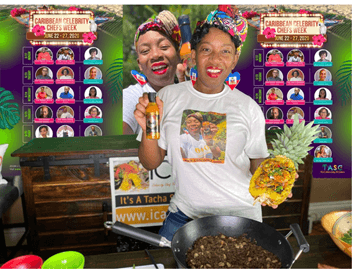Warm Up to the Flavors of a Creole Christmas in the Caribbean

[ATLANTA] – Creole cuisine is a fusion of historical influences and the indigenous and colonial cooking methods that have helped to shape the Caribbean’s diverse culinary product.
The 12 Days of Caribbean Cooking Festival is a virtual showcase that will feature the region’s diverse culinary traditions with 28 Caribbean chefs, bakers and culinary artisans, representing 17 Caribbean destinations. Staged November 29 – December 11, 2020 it will showcase a melting pot of food, rums, desserts and other culinary creations that the Caribbean is known for.
Organized by Travel Advisors Selling the Caribbean (TASC), this cooking series will not only explore the flavors of the region but will also reveal history lessons about how many of the flavors evolved.
- see also: 12 Days of Caribbean Cooking Festival Will Celebrate the Rich Culture and Traditions of The Region
Virtual stops on the ”taste trail” include the French speaking territories of Haiti, Guadeloupe and Martinique, as well as former French colonies, Dominica and Saint Lucia, where much of the population speaks Kwéyòl (Creole) – a French-based patois, spoken alongside the official language of English.
The 12 Days of Caribbean Cooking Festival will highlight Christmas culinary traditions throughout the Caribbean. Each recipe will feature local rum as one of the ingredients.
Connecting via ZOOM, chefs will prepare a feast of Caribbean-inspired dishes from the destination that they represent. They will demonstrate simple steps in making mouthwatering dishes in 30 minutes of cooking time.
“I grew up with créole food in Saint Lucia and I describe it as my comfort food. The dishes are cooked slowly and mix ground provisions and spices to achieve the rich flavors of the tropics. This cuisine reflects our African heritage with a hint of French complexity and will appeal to the most discerning palate,” said Kelly Fontenelle, TASC Founder.
It is widely speculated that the genesis of créole cuisine is tied to harsh economic conditions that pushed many slaves to invent their own meals to survive, using their creativity to develop tools to harvest and prepare foods from the lands. A minimalist culture of essential food using fresh ingredients tied to the key nutritional benefits was born, and these foods have been handed down for generations.
For example, when the locals could not afford fine meats, they would make tasty “one-pot” meals made from fresh vegetables and leftover meat or seafood.
In Haiti, Kalalou Djondjon (Haitian okra and black mushroom stew) is a sort of Louisiana-style gumbo made with okra and mushrooms, sometimes served with a kick of chili peppers. This dish stewed with chunks of pork and a healthy dose of crab legs (kalalou djon djon ak sirik ak vyann kochon) is served atop white rice.
HISTORY LESSONS AND THE CREOLE INFLUENCES ON YOUR PLATE
The 12 Days of Caribbean Cooking Festival will highlight local dishes and age-old recipes made by authentic, veritable culinary ambassadors and in some instances, with the help of French translators.
The local créole specialties will combine the finesse of French cuisine with the spices of African cookery and the exoticism of East Indian and Southeast Asian recipes. Throughout these islands the preparation of fish and other meats with vegetables, condiments and spices such as peyi saffron, white and black pepper, cumin and all the varieties of peppers will be combined to make créole cuisine truly sensational.
Guadeloupe
- Chef: Jimmy Bibrac
The French officially claimed Guadeloupe as a colony in 1635 and in 1759, it was occupied by the British but restored to France after 4 short years. In 1946, Guadeloupe became a French département, giving the island a locally elected government that reports to the national government in Paris.
Guadeloupe is reportedly the world’s second largest consumer of fish per capita. Fish broth, soft-shell clam blaff, grilled rock lobster, and conch fricassee are just a few mouth-watering Créole dishes.
Martinique
- Vladimir François-Maïkoouva

- Gaby Martinon

Martinique was colonized by France in 1635 and the island has subsequently remained a French possession except for three brief periods of foreign occupation.
In Martinique, do not miss the crab races, where visitors can learn how to catch the crabs for their next meal. Samoussas, codfish and vegetable accras, palm-heart salad, bonbons piment (‘spicy sweets’) and chicken Colombo are just a snapshot of the delicious créole cuisine that is available in the local eateries that range in ambience from roadside barbecues, to air-conditioned brasseries.
Dominica
- Randy Prosper

Dominica lies between the French islands of Guadeloupe to the north and Martinique to the south. In the country’s long fight to Independence, it was first colonized by the Spanish then was a French colony between the period 1715–1763. Dominica obtained its independence from Britain in 1978. The island’s cuisine is rooted in créole techniques, with local produce flavored by spices found throughout the island. Dominica’s national dish was the mountain chicken which is similar to frog legs that are synonymous to decadent French cuisine.
Saint Lucia
- Orlando Satchel

- Chef Empress Eve
- Edna Butcher
- Jonathon Jean Baptiste

After being alternately under French and British rule for 160 years, St. Lucia remained under British rule from 1803 to 1967, when it became a self-governing state and a fully independent country in 1979. The food is a real mixture of influences – West Indian produce and Creole cooking techniques, a touch of French flair, some British imports and a pinch of African and Indian spices. But what all Saint Lucian food has in common is that it packs rich flavors.
Haiti
- Stephan Berrouet-Durand

- Natacha Supplice-Henry

The island was initially claimed by Spain, which later ceded the western third of the island to France. Prior to gaining its independence in 1804, Haiti was the French colony of Saint-Domingue. Haiti became the second independent nation in the Americas.
Haitian cuisine blends French, African, Spanish and Taino native influences from each of the cultural groups which have played a significant role throughout the country’s history. Peppers and herbs are used to create bold African flavors, while spices like cloves and star anise add a warmth to Haitian. The Haitian flavor base known as épice forms the foundation of many dishes, comprising green onions, thyme, parsley, peppers and garlic.


